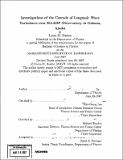Investigations of the cascade of Langmuir wave turbulence over HAARP Observatory in Gakona, Alaska
Author(s)
Burton, Laura M
DownloadFull printable version (1.857Mb)
Other Contributors
Massachusetts Institute of Technology. Dept. of Physics.
Advisor
Min-Chang Lee and Richard Temkin.
Terms of use
Metadata
Show full item recordAbstract
This thesis investigates the cascade lines from Langmuir wave turbulence as a result of Parametric Decay Instability (PDI) in the ionosphere. This effect is studied using a high-frequency (HF) heater located at the NSF/DoD High Frequency Active Auroral Research Program (HAARP) Observatory in Gakona, Alaska. Measurements were taken remotely in February 2005 and March 2006 in order to focus study on the altitude variation and number of cascade lines. This data was cross-checked with a recently developed theory by Kuo and Lee [2005] citing two processes possible in PDI: resonant decay and non-resonant decay. The non-resonant cascade of Langmuir waves proceeds at the same location and is severely hampered by frequency mismatch effect, because the decay wave is a driven ion mode oscillating at considerably lower frequency than that of the ion acoustic wave. In contrast, the resonant cascade, which takes place at different resonant locations to minimize the frequency mismatch effect, has to overcome the propagation loss of the mother Langmuir wave in each cascade step. It is known, in general, that the resonant cascade process requires less thresholds than those of the non-resonant cascade process. Thorough analysis concludes that resonant decay is the most probably process due to observed altitude variation and number of cascade lines observed.
Description
Thesis (S.B.)--Massachusetts Institute of Technology, Dept. of Physics, 2007. Includes bibliographical references (leaf 49).
Date issued
2007Department
Massachusetts Institute of Technology. Department of PhysicsPublisher
Massachusetts Institute of Technology
Keywords
Physics.